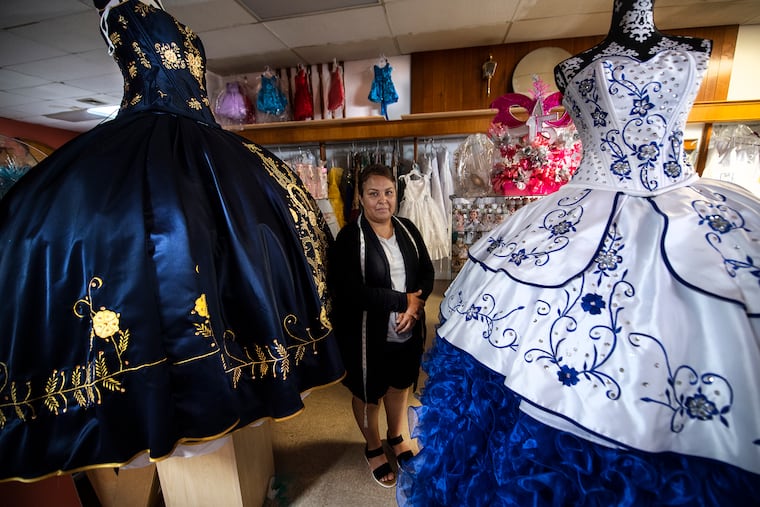A new vision for an old city in South Jersey
Bridgeton boosters focus less on what their city has lost and more on what it has gained in the last 25 years: New residents from Mexico and elsewhere in Latin America who have brought a welcome vitality to downtown.

The days when downtown Bridgeton had a hotel, movie theaters, department stores, and a train station are long gone. Like the Bridgeton Evening News, the locally owned publication that told the little city’s stories for more than a century, the lost landmarks and hallmarks of Bridgeton life are unlikely to come back.
So why are Amy Petrie, Rosalinda Garcia, and Deborah Boykin-Greenberg, with whom I had a scrumptious lunch recently at the El Sabor Mexicano restaurant on East Commerce Street, so unabashedly enthusiastic about the future of their city’s faded but still-beating heart?
It’s because they and other Bridgeton boosters focus less on what their city has lost and more on what it has gained in the last 25 years: New residents from Mexico and elsewhere in Latin America who have brought a welcome vitality to downtown.
“The city is 51 percent Hispanic, and we’re promoting that diversity," said Petrie, the executive director of the nonprofit Bridgeton Main Street Association (downtownbridgeton.com). “We have restaurants, clothing stores, shoe stores, and grocery stores. Downtown is accessible, walkable, and safe."
People need to get over “preconceptions” about downtown Bridgeton, said Boykin-Greenberg, who has memories of the city’s heyday and sees a new one on the horizon.
“Bridgeton was always diverse, and that’s the biggest thing we have to offer," Boykin-Greenberg said, noting the area’s deep Nanticoke Leni-Lenape heritage. "Let’s showcase the diversity, and all of the food and the culture that come with it.”
And as Garcia, an entrepreneur and real estate investor who opened the Cohansey Cafe downtown in June, put it: “Bridgeton has a lot of potential.”
A city of 24,000, and the seat of mostly rural Cumberland County, Bridgeton has a substantially intact downtown full of architecturally eclectic commercial buildings from the 19th century and the first half of the 20th. Those were the days when glassmaking and other industries along the Cohansey River employed thousands.
There’s now an attractive promenade along the downtown expanse of the Cohansey, across Commerce Street from the entrance to Bridgeton City Park, a 1,000-acre expanse of woods, trails, lakes, and even a zoo. The park is lovely, as is an adjacent residential neighborhood, and the city’s gently rolling terrain is itself an asset in South Jersey’s relatively flat landscape.
But Bridgeton’s challenges are obvious as well. The city is off the beaten track; it takes a while to get downtown from the Bridgeton exit of Route 55. The sagging porches of some of the distinctive Victorian twin homes along Route 77 and in older neighborhoods attest to the fact that fully one-third of residents live in poverty.
"Our biggest challenge is not unique to us,” said Kevin C. Rabago Jr., the director of the city’s Office of Development and Planning. “The question is, how do we redefine Bridgeton’s downtown in a way that is relevant to the community?
“We embrace diversity, and we see it as a strength,” he added. "But not everyone does. Some of our harshest critics are people who’ve moved away. "
The city’s efforts to reinvent its economy go well beyond downtown. Bridgeton is home to the Rutgers Food Innovation Center, a business incubator soon to be joined by a $9.2 million companion facility being developed by the Cumberland County Improvement Authority, in partnership with Rutgers and the city.
The goal is to make Bridgeton a hub for development of advanced, food-related manufacturing enterprises, a nod to the region’s past, when tomatoes and other crops from surrounding farms were transformed into canned or preserved products and distributed nationwide. In 1950, the nearby Seabrook Farms pioneering frozen-food operation employed thousands, many of them immigrants.
Today, some downtown Bridgeton merchants also are connecting to the region’s past, as well as its present. Juan Cuevas opened a cowboy gear shop four years ago on South Laurel Street — his wife, Maryana, owns the adjacent women’s specialty clothing store ― and his customers include performers at the Cowtown Rodeo in nearby Salem County.
“There are a lot of cowboys in the surrounding areas who use this type of boots and this type of clothing,” he said, as Garcia translated from Spanish to English for me. “Cowboys buy their outfits for the rodeos.”
Petrie, who grew up in Bridgeton and moved back to the city last September with her husband and their three children, hopes relatively inexpensive real estate will attract more millennials like herself. The downtown retail vacancy rate is about 11 percent, but the upper floors of many buildings are empty and would make great apartments or creative spaces, she said.
Meanwhile, despite its shoestring budget, the association is working to attract public and private grants for “placemaking” and promotional events. And downtown is a designated “Opportunity Zone,” the federal program aimed at leveraging private investment.
As someone who grew up in a small industrial New England city much like Bridgeton, I’m inclined to agree with Petrie, Garcia, and Boykin-Greenberg that their tough old town’s best days lie ahead.
“I’m from here, I’ve know the history, and I see a shift in perception about downtown,” Petrie said.
“People are nostalgic,” said Rabago. “But you can’t go back.”